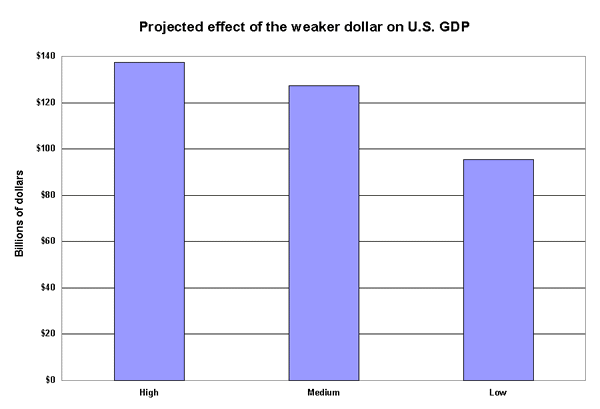Snapshot for June 4, 2003.
Falling dollar, rising economy
The value of the U.S. dollar has fallen by 8.8% since its peak in February 2002.1 There is much confusion over whether this is a positive or negative development, part of which arises from the traditional stance of the U.S. Treasury Department (in both the Clinton and Bush Administrations) in favor of a “strong dollar policy.”
A falling dollar has both costs and benefits. The primary costs of a weaker dollar are higher prices for imported goods and for American travelers abroad. The primary benefit is increased competitiveness in the price of U.S. exports in foreign markets. The United States is currently running an enormous trade deficit (importing more than it exports), which represents a significant drag on efforts to stimulate economic growth and create jobs. Given this, the benefits of greater international competitiveness spurred by the dollar decline greatly outweigh the costs.

It takes about 12 to 18 months to reap the benefits of a more competitive currency value. The figure above illustrates three estimates of the positive effect that the falling dollar will have on U.S. gross domestic product (GDP) over the 12- to 18-month time period.2 The highest estimate assumes a very strong response of net exports to the high value of the dollar, while the medium and low estimates assume progressively weaker effects.
Essentially, the weaker dollar will likely add somewhere between $95 billion to $140 billion (0.8% to 1.3%) to U.S. GDP across the next 18 months. While this is a significant boost to the U.S. economy in the short term, it represents only a quarter to a third of the total current U.S. trade deficit. Even further dollar adjustment is needed for long-term economic sustainability.
1. Based on the real, broad, trade-weighted exchange index of the Federal Reserve.
2. Estimates based on author’s calculations of export and import growth between the United States and its trading partners. These calculations use data on current U.S. imports, exports, and GDP from the Bureau of Economic Analysis and the Census Bureau and data on the GDP of U.S. trading partners and projected growth from the International Monetary Fund (IMF) World Economic Outlook.
This week’s Snapshot by EPI economist Josh Bivens.
Check out the archive for past Economic Snapshots.
